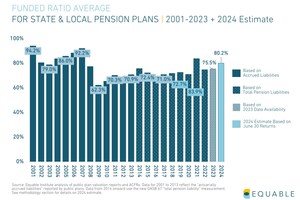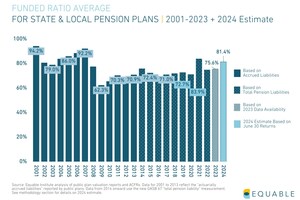Public pension funding shortfall expected to flatline at $1.49 trillion and funded ratio expected to rise marginally to 77.4%, marking a return to the stagnation of the post-Great Recession era
NEW YORK, July 18, 2023 /PRNewswire/ -- State and municipal retirement systems are on track to miss their investment targets and are unlikely to see meaningful improvements in their unfunded liabilities or funded ratio in 2023, according to Equable Institute's State of Pensions 2023 report. Following significant losses in 2022 due to negative investment returns, unfunded liabilities grew to $1.57 trillion, bringing the national aggregate funded ratio to 75.4%. Equable estimates that the aggregate funded ratio for U.S. state and local pension funds will rise marginally to 77.4% in 2023 and unfunded liabilities will remain effectively flat at $1.49 trillion year over year, driven by underperforming investments. This marks a return to the stagnant funding levels seen in the decade following the Great Recession.
In the first half of 2023, market returns improved over 2022's bear market. However, the performance of state and local pension funds' investments (5.3% on average) have not met plan's investment targets. Looking forward, Equable Institute's analysis finds that the long-term outlook for pension funds in 2023 and beyond will likely be shaped by converging pressures of risk addiction, market uncertainty, and increasing politicization of asset management activities.
"The increasing addiction to investment risk has meant exposing public employee retirement assets to the volatility of highly interconnected global markets. In just the past fiscal year, asset values were shaken by rapidly changing interest rates, a crypto-economy crisis (capped by the collapse of FTX), a community bank crisis (marked by the failure of SVB Financial), an unexpected A.I.-driven market rebound, and more," said Anthony Randazzo, Equable Institute executive director.
"Beyond volatility, the heavy expansion into alternative asset classes that don't have robustly transparent market prices — like private equity and real estate — means that each retirement system needs to start accounting for the amount of 'valuation risk' that their portfolio poses to the state and local government budgets in their jurisdiction. All of these trends complicate the long-term outlook for plans," Randazzo noted.
The report, State of Pensions 2023, analyzes trends in public pension funding, investments, contributions, cash flows, and benefits for 225 of the largest statewide and municipal retirement systems in all 50 states (e.g., retirement plans with at least $1 billion in accrued liabilities).
Looking back on a year of mixed market signals, the analysis concludes that the state of pensions remains fragile. Specifically, the report finds:
- Preliminary 2023 investment returns for state and local plans are 5.3% on average, through June 30, 2023. Most public pension plans are projected to underperform their assumed return targets (6.9% on average). The net result is a marginal improvement in funded ratio, while unfunded liabilities will remain stable.
- Pension funds have more money in alternative investments like private equity, real estate, and hedge funds than at any point in history — both in dollar terms ($1.63 trillion) and share of asset allocations (34.0%). Markdowns to these asset classes in 2023 emphasize how exposed public pensions are to "valuation risk."
- Employer contribution rates have passed 30% of payroll on average for the first time in U.S. history. Roughly two-thirds (73%) of costs are for unfunded liability payments.
- Unfunded liability payments have risen 2,089% in the last two decades – from under $5 billion in 2001 to over $100 billion in 2022.
- States have continued to temper their investment assumptions. The average assumed rate of return is now 6.88%, down slightly from 6.92% in 2022—which was the first dip below a 7% average in modern history. There are now 92 state and local plans assuming investment returns below 7%, as of June 2023. In 2003, just 3 plans expected returns of 7% or less.
- While investment assumptions are falling, they are still well above the assumed rates of return that both historic trends and capital market forecasts indicate are reasonable. Based on historic interest rate trends, the average assumed rate of return should be below 6.5% if pension funds had maintained the same level of investment risk that they had in 2001 when they were last fully funded. Forward looking forecasts, suggest there is just a 40% chance of earning a 6.5% assumption in the coming years. Together, this suggests that assumed returns will likely continue to decline in the coming years.
- More laws were adopted in 2023 concerning pension funds' investments related to ESG than any other year on record. However, only a few are likely to influence pension fund investing decisions.
- There are significantly more pension fund assets that are being influenced by pro-ESG sentiments than anti-ESG views. More than $2.4 trillion in assets are under management in pro-ESG states compared to $708 billion in anti-ESG states.
For a deeper look into The State of Pensions 2023, visit http://www.equable.org/state-of-pensions-2023 to access additional downloads and interactive data visualizations. Media tools including figures, fact sheets and raw data can be found here.
About Equable Institute
Equable is a bipartisan non-profit that works with public retirement system stakeholders to solve complex pension funding challenges with data-driven solutions. We exist to support public sector workers in understanding how their retirement systems can be improved, and to help state and local governments find ways to both fix threats to municipal finance stability and ensure the retirement security of all public servants.
Equable.org | Twitter: @EquableInst | Facebook: @EquableInstitute | Instagram: @EquableInst
SOURCE Equable Institute

WANT YOUR COMPANY'S NEWS FEATURED ON PRNEWSWIRE.COM?
Newsrooms &
Influencers
Digital Media
Outlets
Journalists
Opted In





Share this article